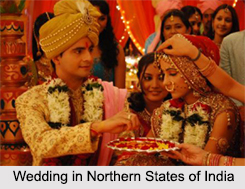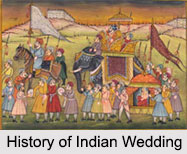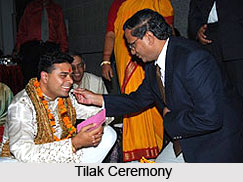 India is a diverse country and each part of the country has a different marriage ceremony and customs. In traditional North Indian weddings, the main ceremony takes place at the brides" home. There are many pre-wedding and post-wedding ceremonies as well. These rituals have a deeper symbolic relevance and a certain quaint charm and appeal.
India is a diverse country and each part of the country has a different marriage ceremony and customs. In traditional North Indian weddings, the main ceremony takes place at the brides" home. There are many pre-wedding and post-wedding ceremonies as well. These rituals have a deeper symbolic relevance and a certain quaint charm and appeal.
Rituals in Wedding in Northern States of India
The most important of the former is the "Mangni" or "Sagaai" or engagement ceremony. A day before the wedding "Mehendi" ceremony is arranged. Mehendi is applied on the hands of the bride. On the auspicious day of the wedding, the bride"s father treats the groom with yogurt and honey and graciously welcomes him into the household. One of the most important of North Indian wedding traditions is the exchanging of garlands, commonly referred to as the "Jaimala" ceremony and is symbolic of accepting one another.
The ceremonial fire or "Havan" is lit and Agni is invoked to witness the occasion. Fire is regarded as a purifying element in Hindu rites and rituals. The couple then offers sacrifice or "Rajaham" to the fire. This is typical to North Indian wedding traditions. The ritual that follows next is the "Gath Bandhan", symbolic of eternal ties. Then it is the turn of what is regarded as the most important all North Indian wedding traditions – the "Saat Phere" or "Mangal Phere". The bride and groom circle the fire often holding hands and take vows to be beside each other throughout their lives. Both sets of parents and other elders of the family then bless the newly wedded couple.
North Indian wedding traditions also include putting on the "Mangalsutra" as well and application of vermillion on the bride"s head by the groom. Once this is done the marriage is considered complete. This is custom that is common across north India. "Bidaai" is the ceremony where the bride bids goodbye to her parents and moves in to her new family. The custom is to throw rice and coin behind as she leaves the house. These are some of the customs that are commonly followed in Wedding in Northern States of India.



















